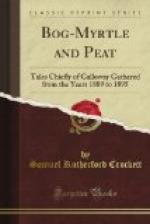But there was one element in the meeting that the Kers had taken no notice of. There was but one woman there, and she a girl. In the corner of the schoolroom, on the chairman’s right hand, sat Grace Hutchison, daughter of the manse. The minister was a widower, and this was his only daughter. She was nineteen. She kept his house, and turned him out like a new pin. But the parish knew little of her. It called her “the minister’s shilpit bit lassie.”
Her face was indeed pale, and her dark eyes of a still and serene dignity, like one who walks oft at e’en in the Fairy Glen, and sees deeper into the gloaming than other folk.
Grace Hutchison accompanied her father, and sat in the corner knitting. A slim, girlish figure hardly filled to the full curves of maidenhood, she was yet an element that made for peace. The younger men saw that her lips were red and her eyes had the depth of a mountain tarn. But they had as soon thought of trysting with a ghaist from the kirkyaird, or with the Lady of the Big House, as with Grace Hutchison, the minister’s daughter.
So it happened that Grace Hutchison had reached the age of nineteen years, without knowing more of love than she gathered from the seventeenth and eighteenth century books in her father’s library. And one may get some curious notions out of Laurence Sterne crossed with Rutherfurd’s Letters and The Man of Feeling.
“It is moved and seconded that the meetings be opened with prayer.”
Objected to by Doctor Hutchison, ostensibly on the ground that they are engaged in a purely practical and parochial business, really because it is proposed by Mr. Calvin and seconded by Saunders Ker. Loyalty to the National Zion forbade agreement. Yet even Dr. Hutchison did not see the drift of the motion, but only had a general impression that some advantage for the opposition was intended. So he objected. Then there was a great discussion, famous through the parish, and even heard of as far as Polmont and Crossraguel. William Henry Calvin put the matter on the highest moral and spiritual grounds, and is generally considered, even by the Government party, to have surpassed himself. His final appeal to the chairman as a professing minister of religion was a masterpiece. Following his minister, Saunders Ker put the matter practically in his broadest and most popular Scots. The rare Howpaslet dialect thrilled to the spinal cord of every man that heard it, as it fell marrowy from the lips of Saunders; and when he reached his conclusion, even the ranks of Tuscany could scarce forbear to cheer.
“Ye are men, ye are faithers, near the halewar o’ ye—maist o’ ye are marriet. Ye mind what ye learned aboot your mither’s knee. Ye mind where ye learned the twenty-third psalm on the quiet Sabbath afternoons. Ye dinna want to hae yer ain bairns grow up regairdless o’ a’ that’s guid. Na, ye want them to learn the guid an’ comfortable word in the schule as ye did yoursel’s. Ye want them to begin wi’ the psalm o’ Dawvid an’ the bit word o’ prayer. Can ye ask a blessin’ on the wark o’ the schule, that hasna been askit on the wark o’ the schule-board? Gin ye do, it’ll no be the first time or the last that the bairn’s hymn an’ the bairn’s prayer has put to shame baith elder an’ minister.”




